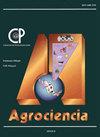灌溉半干旱条件下本地玉米饲料和青贮的产量和化学成分
IF 0.5
4区 农林科学
Q4 AGRICULTURE, MULTIDISCIPLINARY
引用次数: 0
摘要
本地玉米的保存允许在特定地区选择具有饲料潜力的基因型。本研究的目的是评价在半干旱条件下灌溉条件下10个具有饲料潜力的本地玉米和2个商品玉米杂交种的青贮产量和青贮化学成分。基因型按雄性开花天数分为早花(80 d)、中花(92 d)和晚花(111 d)。数据分析采用随机完全区组设计,共4个重复(Tukey;α = 0.05)。中后期玉米的株高、总干物质产量和叶片数最高(p < 0.05)。后期基因型的穗轴产量和衰老物质均显著高于对照组(p < 0.05)。基因型Olotillo × Tuxpeño和Tuxpeño II在TDMY(平均14.32 Mg ha-1)上优于2038DK和P3966WP(分别为3.50和9.24 Mg ha-1)。Olotillo × Tuxpeño与P3966WP在绿色饲料中的粗蛋白质值相近(81 g kg-1;P > 0.05)。然而,青贮后,杂交玉米的表现比本地玉米高出22%(92比75 g kg-1;P < 0.05)。晚周期本地玉米穗轴产量最高(4.59 Mg ha-1),青贮后理想pH值< 3.9)和°Brix值(8.5)。本地基因型Tuxpeño I、Olotillo × Ratón、Olotillo × Tuxpeño和Tuxpeño II可用于育种计划,以选择具有饲料生产和保护潜力的材料。本文章由计算机程序翻译,如有差异,请以英文原文为准。
YIELD AND CHEMICAL COMPOSITION OF FORAGE AND SILAGE OF NATIVE MAIZE UNDER IRRIGATED SEMI-ARID CONDITIONS
The preservation of native maize allows the selection of genotypes with forage potential in specific regions. The objective of the present study was to evaluate the yield and chemical composition of green forage and silage of 10 native and two commercial maize hybrids with forage potential, under semi-arid conditions with irrigation. Genotypes were grouped according to days to male flowering: early (80 days), intermediate (92 days) and late (111 days). Data were analyzed in a randomized complete block design with four replications (Tukey; α = 0.05). Intermediate and late maize had the greatest height, total dry matter yield (TDMY) and number of leaves (p < 0.05). Late genotypes showed higher values in cob yield and senescent matter (p < 0.05). The genotypes Olotillo × Tuxpeño and Tuxpeño II outperformed the hybrids 2038DK and P3966WP (3.50 and 9.24 Mg ha-1, respectively) in TDMY (14.32 Mg ha-1, on average). Olotillo × Tuxpeño and P3966WP presented similar crude protein values in green forage (81 g kg-1; p > 0.05). However, when ensiled, the hybrid outperformed native corn by 22 % (92 vs. 75 g kg-1; p < 0.05). Late-cycle native maize had the highest cob yields (4.59 Mg ha-1) and after ensiling, the ideal pH (< 3.9) and °Brix (8.5) values. The native genotypes Tuxpeño I, Olotillo × Ratón, Olotillo × Tuxpeño and Tuxpeño II could be used in breeding programs to select materials with potential for forage production and conservation.
求助全文
通过发布文献求助,成功后即可免费获取论文全文。
去求助
来源期刊

Agrociencia
农林科学-农业综合
CiteScore
0.50
自引率
33.30%
发文量
51
审稿时长
18-36 weeks
期刊介绍:
AGROCIENCIA is a scientific journal created and sponsored by the Colegio de Postgraduados. Its main objective is the publication and diffusion of agricultural, animal and forestry sciences research results from mexican and foreign scientists. All contributions are peer reviewed. Starting in the year 2000, AGROCIENCIA became a bimonthly and fully bilingual journal (Spanish and English versions in the same issue). Since 2007 appears every month and a half (eight issues per year). In addition to the printed issues, the full content is available in electronic format.
 求助内容:
求助内容: 应助结果提醒方式:
应助结果提醒方式:


